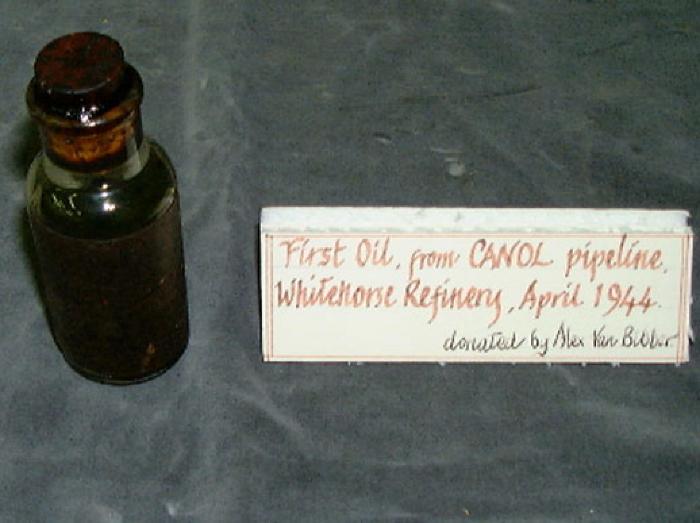Specimen, Geological
Object
1993.551
Mineral sample.
Sample of Canol Refinery oil in a glass bottle. Reads 'First Oil from CANOL pipeline, Whitehorse Refinery, April 1944 donated by Alex Van Bibber'
The Canol pipeline was approved by the Canadian government on May 8th, 1942. It was designed to ship 3000 barrels of oil a day from the Imperial Oil Field at Norman Wells to a refinery in Whitehorse and then send the refined oil to Fairbanks. The American military feared a Japanese attack on Alaska and wanted a safe reliable source of oil.
Canol, short for Canada and oil, was a four-inch line which would eventually stretch over 1600 miles. By the spring of 1943, the American troops were gone and construction was being carried on by civilian contractors.
In the two years it took to build Canol, over 52,000 people worked on the project. At its peak there were ten thousand people working on the project at one time. It was actually three projects in one: the pipeline from Norman Wells to Whitehorse, a distribution system out of Whitehorse, and the Canol Road from Johnson’s Crossing.
http://www.hougengroup.com/yukonHistory/nuggets_year/2000s.aspx?nugget=1945
The refinery at Whitehorse was shipped in from Texas and cost 24 million dollars. The route for the pipeline was chosen by aerial surveys and from talking to local native people who used a trail over the MacKenzie Mountains.
On February 16, 1944, they met and the line was joined. Two months later, oil was flowing from Norman Wells, through ten pumping stations, to the Whitehorse refinery.
But the 3000 barrels a day the line could deliver was a drop in the bucket compared to the needs of the American military in Alaska. The line operated for just nine months before the refinery was shut down. The official cost of the line was put at 134 million dollars, but many believe it cost as much as 300 million… and that was in 1944 dollars.
Canol, short for Canada and oil, was a four-inch line which would eventually stretch over 1600 miles. By the spring of 1943, the American troops were gone and construction was being carried on by civilian contractors.
In the two years it took to build Canol, over 52,000 people worked on the project. At its peak there were ten thousand people working on the project at one time. It was actually three projects in one: the pipeline from Norman Wells to Whitehorse, a distribution system out of Whitehorse, and the Canol Road from Johnson’s Crossing.
http://www.hougengroup.com/yukonHistory/nuggets_year/2000s.aspx?nugget=1945
The refinery at Whitehorse was shipped in from Texas and cost 24 million dollars. The route for the pipeline was chosen by aerial surveys and from talking to local native people who used a trail over the MacKenzie Mountains.
On February 16, 1944, they met and the line was joined. Two months later, oil was flowing from Norman Wells, through ten pumping stations, to the Whitehorse refinery.
But the 3000 barrels a day the line could deliver was a drop in the bucket compared to the needs of the American military in Alaska. The line operated for just nine months before the refinery was shut down. The official cost of the line was put at 134 million dollars, but many believe it cost as much as 300 million… and that was in 1944 dollars.
